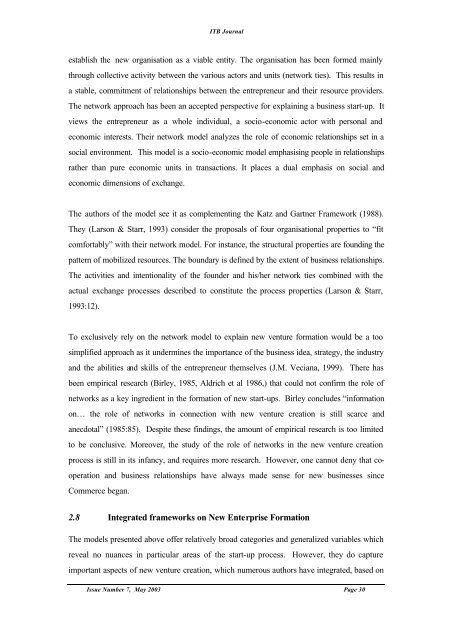ITB Journal-May-2003 - Institute of Technology Blanchardstown
ITB Journal-May-2003 - Institute of Technology Blanchardstown
ITB Journal-May-2003 - Institute of Technology Blanchardstown
Create successful ePaper yourself
Turn your PDF publications into a flip-book with our unique Google optimized e-Paper software.
<strong>ITB</strong> <strong>Journal</strong><br />
establish the new organisation as a viable entity. The organisation has been formed mainly<br />
through collective activity between the various actors and units (network ties). This results in<br />
a stable, commitment <strong>of</strong> relationships between the entrepreneur and their resource providers.<br />
The network approach has been an accepted perspective for explaining a business start-up. It<br />
views the entrepreneur as a whole individual, a socio-economic actor with personal and<br />
economic interests. Their network model analyzes the role <strong>of</strong> economic relationships set in a<br />
social environment. This model is a socio-economic model emphasising people in relationships<br />
rather than pure economic units in transactions. It places a dual emphasis on social and<br />
economic dimensions <strong>of</strong> exchange.<br />
The authors <strong>of</strong> the model see it as complementing the Katz and Gartner Framework (1988).<br />
They (Larson & Starr, 1993) consider the proposals <strong>of</strong> four organisational properties to “fit<br />
comfortably” with their network model. For instance, the structural properties are founding the<br />
pattern <strong>of</strong> mobilized resources. The boundary is defined by the extent <strong>of</strong> business relationships.<br />
The activities and intentionality <strong>of</strong> the founder and his/her network ties combined with the<br />
actual exchange processes described to constitute the process properties (Larson & Starr,<br />
1993:12).<br />
To exclusively rely on the network model to explain new venture formation would be a too<br />
simplified approach as it undermines the importance <strong>of</strong> the business idea, strategy, the industry<br />
and the abilities and skills <strong>of</strong> the entrepreneur themselves (J.M. Veciana, 1999). There has<br />
been empirical research (Birley, 1985, Aldrich et al 1986,) that could not confirm the role <strong>of</strong><br />
networks as a key ingredient in the formation <strong>of</strong> new start-ups. Birley concludes “information<br />
on… the role <strong>of</strong> networks in connection with new venture creation is still scarce and<br />
anecdotal” (1985:85). Despite these findings, the amount <strong>of</strong> empirical research is too limited<br />
to be conclusive. Moreover, the study <strong>of</strong> the role <strong>of</strong> networks in the new venture creation<br />
process is still in its infancy, and requires more research. However, one cannot deny that cooperation<br />
and business relationships have always made sense for new businesses since<br />
Commerce began.<br />
2.8 Integrated frameworks on New Enterprise Formation<br />
The models presented above <strong>of</strong>fer relatively broad categories and generalized variables which<br />
reveal no nuances in particular areas <strong>of</strong> the start-up process. However, they do capture<br />
important aspects <strong>of</strong> new venture creation, which numerous authors have integrated, based on<br />
Issue Number 7, <strong>May</strong> <strong>2003</strong> Page 30
















